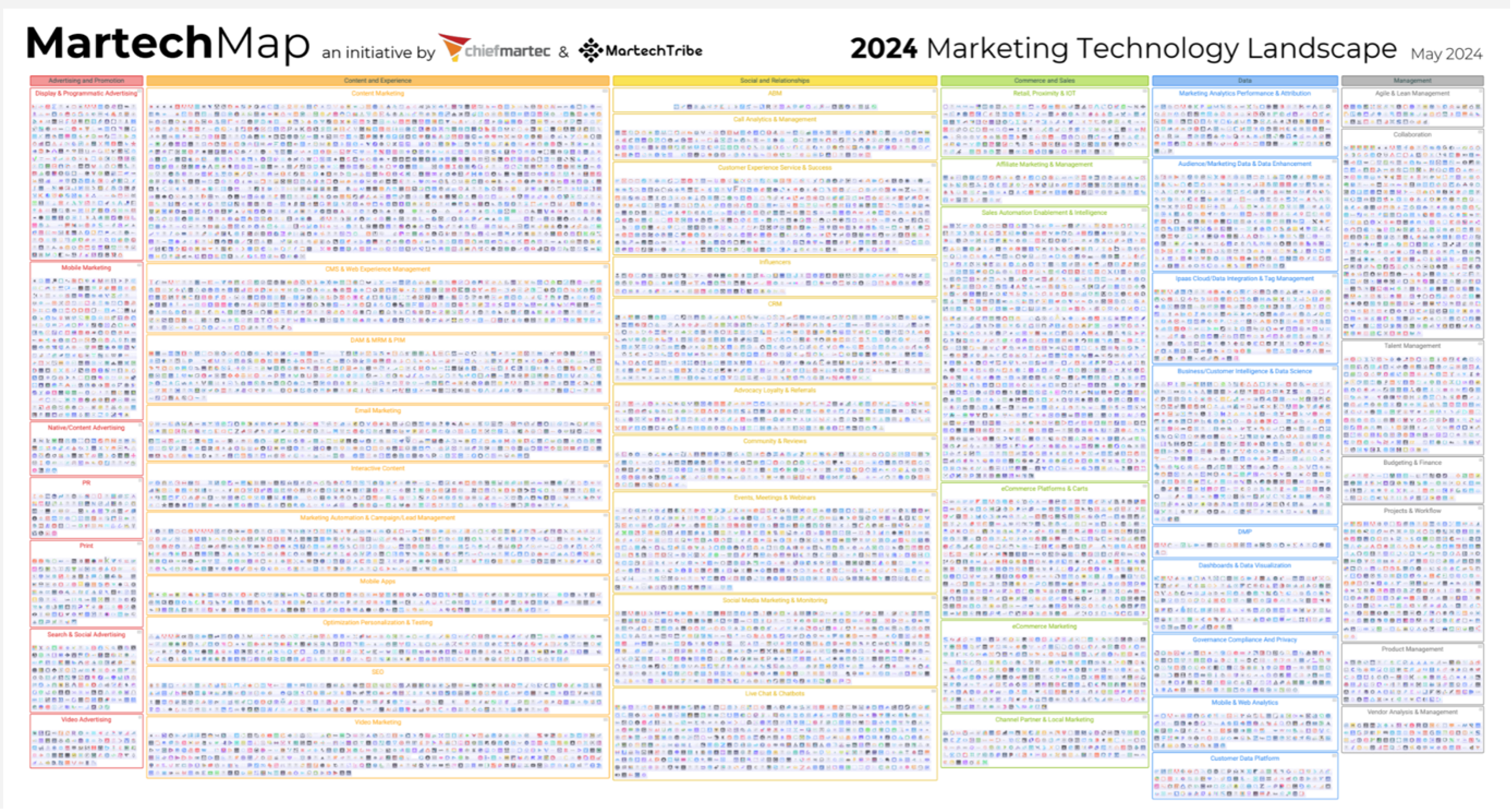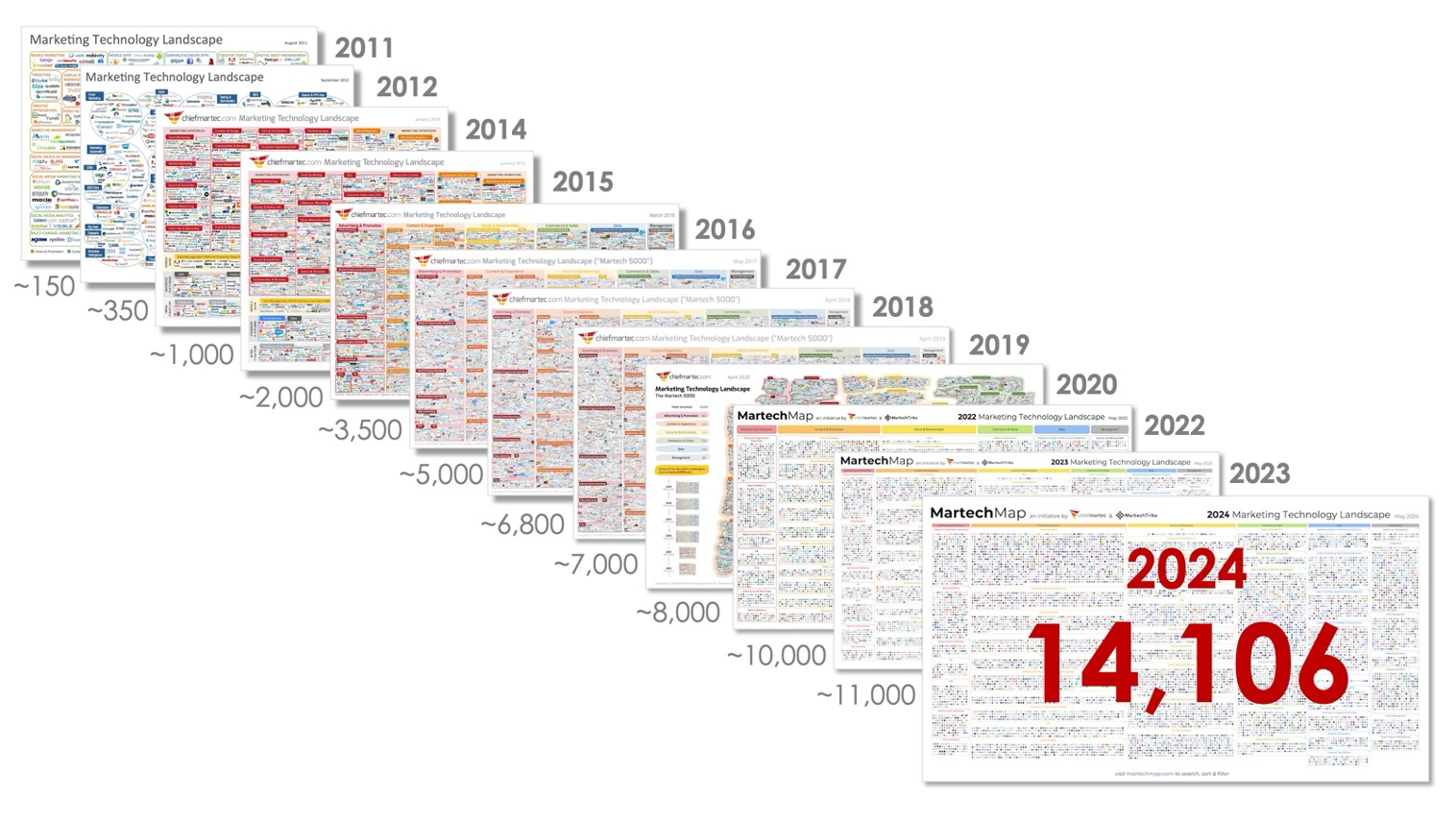The 1 out of 14,106, it may sound like something out of a storybook, like finding a needle in a haystack.

Source here – courtesy of Scott Brinker.
Since 2011, the market for martech solutions has grown steadily to currently over 14,106 solutions.

MartechMap – Supergraphic Courtesy of Scott Brinker. Source here.
But what does this mean for me as an organization? Which solution do I choose? How do I find the right solution?
First of all, it is important not to look for just any solution, but to clearly define what the requirements are. The first step is to define a clear vision of how customers should be perceived and communicated with in the future.
Organizational measures must be derived from this vision. An orientation towards data-driven marketing means a comprehensive change that should be implemented carefully and with a clearly defined roadmap.
A martech solution must fit precisely into this roadmap and support it.
The first step is to determine the current level of maturity. This can be used to define a roadmap with milestones. And this is where the current martech map comes into play. There is no “best” solution that solves all problems. There are many niche products, but also many innovative products that can be perfectly combined alone or in combination with other solutions and selected to fit the organizational change map.
We recommend the following approach:
Determine the maturity level of your company regarding to CXM
Every company has a unique organization. It is important to understand this, analyze functional processes and mirror the existing infrastructure to a CXM reference structure in order to assess the current status. Not every one of the currently more than 14,000 martech solutions is suitable for every maturity level. An individual development plan must be drawn up for your own infrastructure.
During this phase, the maturity level of individual functional and organizational areas is determined and individual steps to increase the maturity level are derived. Based on a CXM reference architecture, current solutions are evaluated, and future requirements are determined. Short, medium and long-term measures are defined. A future martech architecture must fit this individual timetable and enable a possible change in the organization towards a customer-centric, agile organization.
This phase also includes defining a vision for future customer communication.
Based on the results of the analysis, individual requirements for the future martech solution architecture can then be derived and based on these, an individual evaluation of suitable solutions can be carried out.
In the following, we list the necessary steps for selecting a suitable CXM architecture and possible solutions.
Define a company-wide vision for customer understanding
The ideas of Customer Experience Management (CXM) should be at the center of this.
CXM is based on the philosophy that every service and every offer is designed with the customer at the center. By integrating the Voice of the Customer (VoC) into all business processes, companies can align their processes to better meet customer expectations.
The result of the vision should therefore be added value for the end customer, which is created by using the company’s own products or services. Advantages over other competitors should also be emphasized.
This is a cross-company and cross-departmental vision that should also be created within an overarching framework. Representatives from all departments with customer contact (marketing, sales, service) as well as the company management should be involved in the definition, as it represents a decisive basis for the future direction of the company.
Overall, the following key questions are answered by the vision:
- How do we put the customer at the center?
- What added value do we offer the customer?
- What makes us stand out from the competition?
Derivation of a strategy and definition of fields of action
The aim of this phase is to implement the vision. To this end, a strategy for its implementation must be drawn up and fields of action must be defined for its operationalization. It is important to define realistic and measurable goals. These must be prioritized and placed on a short, medium and long-term timeline with corresponding milestones.
In most cases, implementing the identified areas of action means a comprehensive change. For this reason, company management must be involved in this process from the outset so that the steps can be implemented successfully and sustainably.
Definition of individual requirements for new marketing architecture
Based on the findings of the previous stages, functional and technical requirements for the new solution architecture must be drawn up. A decision must be made as to whether an enterprise or best-of-breed approach should be pursued.
In the enterprise approach, individual functions are served by a provider who also guarantees the integration of individual solution modules. In contrast, individual function blocks are served by different manufacturers in the best-of-breed approach. This has the advantage that innovative products can be used, or individual components can be replaced more easily as the level of maturity increases.
The approach also reflects the requirements, as different functional blocks have to be served here.
It is also advisable to define use cases for the respective functional blocks with expectations in order to guarantee the objective comparability of different solutions.
The respective requirements must be synchronized with the milestones and goals of the roadmap for increasing the company’s own level of maturity.
To enable the integration of solution manufacturers, it is advisable to summarize the requirements in one document.
Definition Short List
A market analysis can be carried out with the defined requirements. It is advisable to involve external experts from the outset, as they have broad market expertise and can use the requirements to narrow down the solution corridor in a targeted and cost-saving manner.
The aim of the short list is to draw up a list of suitable solutions and manufacturers. The degree of fulfillment of the requirements must be documented and comprehensive manufacturer information must be consolidated.
The evaluation team decides which solutions should be considered in more detail as part of a presentation of the results.
Definition of use cases
Practical use cases help you to find the right solution. Therefore, define corresponding use cases based on your experience and the current requirements of your teams and use these as the basis for the presentation of the solutions or share them with the solution providers, who then show how the corresponding cases are implemented in the solution. This is the only way to create a practical reference, and future users can immediately see how the individual solutions need to be operated.
Definition of objective evaluation criteria
These criteria must be drawn up with the team that also participates in the provider workshops so that a common understanding of the evaluation is established, and an objective evaluation can be carried out.
Implementation of provider workshops
In these workshops, selected providers conduct solution workshops together with the evaluation team. Here it is shown how defined use cases and requirements can be implemented in the respective solutions. Specific questions can also be asked here.
The individual solutions are evaluated here using the predefined evaluation criteria.
Decision
During the decision phase, one or more possible winners are selected based on the evaluation criteria. If several solutions are considered for the future CXM architecture, it is recommended to start a PoC phase with these.
Summary
Finding the right solution is not a trivial process and is highly individual to the needs of the respective organization.
We recommend the following key points:
- Establish a strategy before selecting any solution
- Define a communication strategy prior to selecting any solution
- Set milestones based on a road map
- Capture all roadmap potentials with the solution
- Involve the appropriate stakeholders in the evaluation – the more practice, the better
- Define practical use cases and use these to see how they are implemented in a new solution
- Use objective evaluation criteria
- Remember that a new solution also means organizational change – use the change to break down organizational silos and standardize your marketing processes. The chosen solution should support and promote this change
We help you to create a CXM architecture tailored to your needs and find the right solutions!
Related articles
Marketing Automation with Like Reply
Like Reply is a specialized expert in digital communication with offices in Munich, Milan and Paris. We support companies in the introduction and development of automated communication as well as in the systematic, effective management of leads and customer relationships. Contact us without obligation and find out how we can take the use of Marketing Automation to the next level together.


